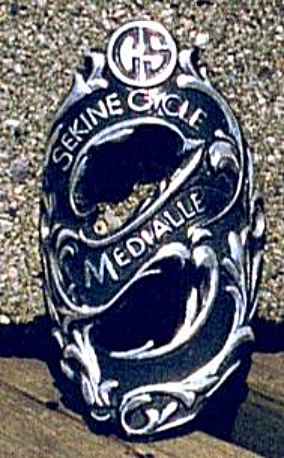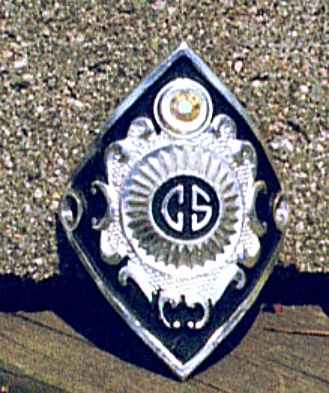CANADIAN & VINTAGE LIGHTWEIGHT BICYCLE
SEKINE CYCLES HISTORY
e-mail [email protected]


In the early seventies, perhaps even late sixties, the Canadian government, feeling pressure from a major domestic bicycle manufacturer who happened to have a bit of a strangle hold on the Canadian bicycle market at the time, elected to impose an import tariff on bicycles coming into the country. In an effort to avoid this twenty-five percent tax, Sekine Cycles opened shop in Oo-za-we-Kwun Rivers, in the province of Manitoba. The year was 1973.
For a short while, the newly formed Sekine Cycles company enjoyed great success. Quality, Canadian made, bicycles rolled off of the assembly line and Sekines soon became know for their excellent quality, a reputation which still holds today. Frame paint was electrostatically applied, resulting in an overall finish on the bicycles that was, all but, unparalleled in the industry. One long time bicycle mechanic commented, "It was a pleasure to assemble new Sekines." Thanks to attention to detail and considerable pre-assembly work, on the part of the Sekine company, set up time for new bikes was considerably reduced. Handlebars arrived with levers installed and bars taped. It was quite possible to set up a new Sekine in approximately half the time of similar competing brands. A bicycle mechanic of considerable experience (he worked on these early bikes as a young man) remarked that he had never seen any brazing gaps left in the Sekine�s lug work, once again suggesting pride in and quality of workmanship. The quality demonstrated in every Sekine bicycle far exceeds that of its major competitor of its day, the Canadian Cycle and Motor Company (CCM). Not only did the Canadian made Sekines provide serious competition to the one time premier bicycle manufacturer, but they were often better made than many of the bicycles being imported during the "Bike Boom" era.
Sekine Cycles� period of little challenged prosperity was short lived. The Canadian government saw fit to lower the tariff on bicycle imports, from 25% to 15%, in 1975. This encourage a new rush of imports, which proved to be bad news for Sekine Canada, as well as other domestic bicycle manufacturers of the time.
Sekine continued in production until the early eighties. Increased competition from a rash of newer and more efficient Canadian bicycle plants, such as Raleigh and Peugeot, forced Sekine Cycles to close its doors in the early eighties. The indexed shifting Toledo or the very nicely appointed Sekine R200 are, perhaps, among the last of the bikes to roll out of the Canadian factory. Such a shame, because Sekine did offer the consumer a quality product.
Like its competitors, Sekine Cycles targeted all levels of road bicycling interest, from the SHA, the bottom of the line model, barely a step above the upper end department store bicycles, to the impressive and extremely well presented Sekine SHX.
The basic Sekine SHA was nothing at all special. Steel center-pull brake calipers and safety lever equipped steel brake controls were indicative of the kind of componentry available on these bikes. The lower end models did, however, sport a unique and often times well remembered head badge containing a single rhinestone. Many of the people, whose interest focused on ten speeds in the those days, fondly remember this unique badge and often go on to comment on how good the Sekines, of their day, were.
SHA handlebars were simple steel offerings. Transmission duties were handled by near bottom of the line Shimano components like the Lark rear derailleur and the Thunderbird on the front. Shifting, however, was not a problem. These lower end bikes looked good, worked well and proved to be effectively tempting to entry level bicyclists. Steel hubs and 27� wheels completed the component package. The frames themselves were nothing special, sporting no tubing decals promising fabrication from some wonder material with a nice butt. All in all, the low end Sekine was a well made bicycle that could be had for a modest price, unlike its more sophisticated brother, the SHX that sold for $439.95 Canadian in 1976 (as reported by a long time local bicycle shop owner who sold Sekines in the seventies).
The Sekine SHB, built in Japan, and its Canadian built counterpart, the SHC, were the next models up. These middle of the line bicycles were the lower end Sekine �Medialles�. Unlike their lesser brothers, all components, save the wheel rims, were made of alloy. Shimano �Tourney� center pull calipers were actuated by alloy brake controls, complete with safety levers. Wide flanged alloy hubs, sans quick release mechanisms, held the wheels to the frame, which, once again, was nothing special even though it sported fancier lug work than did the SHA. These mid level bikes all came equipped with quick releases for the front and rear brakes, whereas the SHA employed only brake adjustent screws. Shifting chores were handled with Shimano 500 and the Shimano Titlist rear and front derailleurs, respectively. Down tube friction shifters replaced the stem shifters used on the SHA model. Alloy cotterless cranks were fitted to alloy rings. These �Medialles� included the ornate head badge used on their upper end counterparts.
Second from the top of the line, at the time, was the Sekine �Medialle� SHT. These were very nice bicycles, sporting full chrome moly frames, complete with Shimano forged and machined front and rear dropouts. The rear drops included axle position adjusting screws. Fork tips as well as chain and seat stays were chromed and, as was the case with all Sekines, the overall finish of the paint was excellent. The lug work was the fanciest offered on any of Sekine�s bicycles, even those to come a few years later. Componentry was similar to the SHB and SHC, the transmissions being the major exception. Shimano 600 derailleurs and controls handled the shifting chores and did so remarkably well. These bikes shift like a charm. SR Royal cotterless cranks, fitted with alloy rings, made up part of the power transmission system. All in all, the SHT was, and still is, a very nice bicycle to observe, as well as ride.
The top of the line Sekine �Medialle� SHX included all of the good stuff offered in the SHT version and then some. Dura Ace or Campagnolo Nouvo Record derailleurs and controls handled the gear changing almost flawlessly. Alloy wheels replace the steel ones, found on lesser models. This bicycle might be either an SHT or an SHX, as it is fitted with Campagnolo components. It is a very nice bicycle to ride even though it handles very quickly. The bicycle offers a ride that lacks the stability afforded by competitors like the Canadian built Peugeots or Raleighs, two more bicycle companies that set up shop in Canada during the seventies and early eighties.